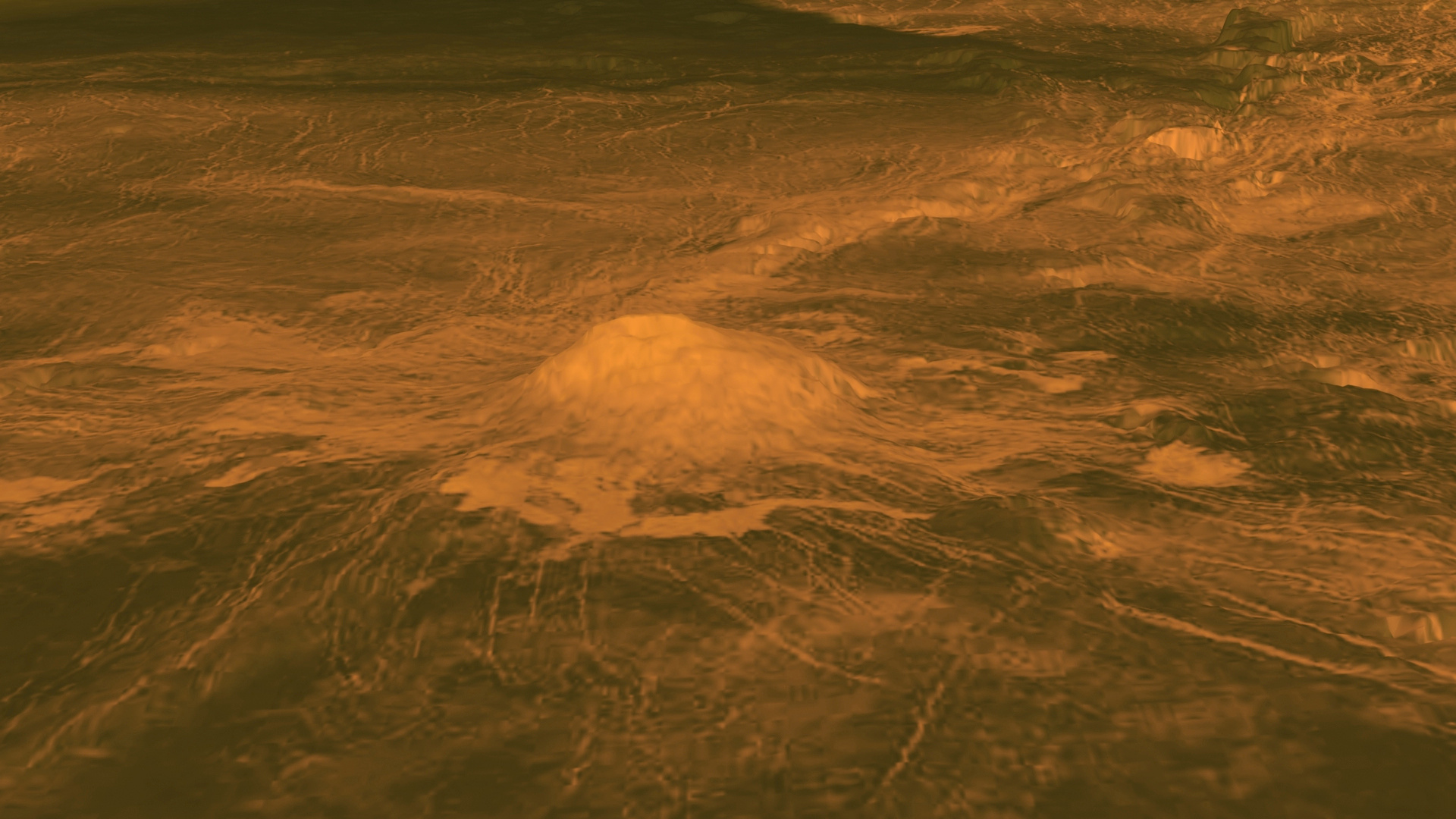Are volcanoes erupting on Venus?
And what could this mean for the possibility of Venusian life?

A volcanic peak standing more than a mile high on Venus may still be active, new findings show, possibly shedding light on hotly debated findings that suggest that life may exist on the hellish planet.
Venus has more volcanoes than any other planet in our solar system. Previous research suggests that Venus possesses more than 1,600 major volcanoes, and could have more than 100,000 or even more than 1 million smaller volcanoes.
However, it has been hotly debated whether any remain active today, as the planet's extreme surface pressure and temperatures make it difficult for surface probes to last very long (if at all) on Venus, and its thick clouds of sulfuric acid limit analysis of its surface from space.
In a new study, researchers analyzed Idunn Mons, a Venusian volcanic peak about 1.5 miles (2.5 kilometers) high and 125 miles (200 km) wide located in Imdr Regio, a volcano-rich highlands region in southern Venus. And they found what they think could be recent activity.
Related: The 10 Weirdest Facts About Venus
Prior research found that the planet does possess fewer craters from cosmic impacts than one would expect given the number of craters pockmarking other rocky planets in the solar system, a finding which suggests that lava from active volcanoes may continue to wipe the planet's surface clean.
A better understanding of volcanic activity on Venus could help shed light on the recent detection of phosphine gas there, which some researchers have controversially suggested may be linked with life on the hellish planet.
Get the Space.com Newsletter
Breaking space news, the latest updates on rocket launches, skywatching events and more!
"The possible presence of phosphine in the atmosphere of Venus may be associated with recent or ongoing volcanic activity," study lead author Piero D'Incecco, a planetary scientist at D'Annunzio University in Pescara, Italy, told Space.com. "Therefore, looking for sites of potentially active volcanism on Venus is crucial."
In 2010, the European Space Agency (ESA)'s Venus Express spacecraft detected infrared anomalies on the top and eastern flanks of Idunn Mons that suggested the presence of fresh volcanic deposits. This provided the first hint that the area might have seen active volcanism in the past few million years.
The researchers analyzed spacecraft observations of the peak for any signs of recent activity. They combined this data with lab studies on how volcanic rock alters when exposed to high surface temperatures and the caustic, sulfurous, carbon-dioxide-rich Venusian atmosphere.
Surface images of the Venusian surface captured by Venus Express and NASA's Magellan spacecraft confirmed the presence of fresh lava flows at Idunn Mons. Atmospheric data from Venus Express also found that winds are slower than expected in the lower atmosphere over Imdr Regio, which the researchers in this new study suggested may be related to heat from recent or ongoing lava flows. The researchers also discovered surface fractures they suggested were evidence of tectonic activity coinciding with volcanic activity.
The scientists also showed that recent lab experiments suggested that surface rock on Venus may chemically change much faster than previously thought. While previous analyses suggested that volcanic flows on Idunn Mons were, at most, 2.5 million years old and as young as 250,000 years old, the new chemical analyses suggest that these rocks were much younger.
All in all, the researchers concluded that Idunn Mons was recently active — possibly anywhere from 10,000 years ago to just a few years ago.
"This is the first time we have combined so many and different data sets to suggest a combination of both recent and potentially ongoing eruptions, as well as recent tectonic activity, on a terrestrial planet other than Earth," D'Incecco said.
A number of future missions are currently planned to map Venus, including NASA's VERITAS orbiter and ESA's EnVision probe. If Venus is volcanically active, "future missions should target these geologically young provinces for repeated high-resolution measurements to see which could be active," study co-author Justin Filiberto, a planetary scientist at NASA's Johnson Space Center in Florida, told Space.com.
Such missions can help to "investigate which volcanoes have changed, how they have changed and the rate of changing," Filiberto added.
The scientists detailed their findings Oct. 27 in The Planetary Science Journal.
Originally published on Space.com.
Join our Space Forums to keep talking space on the latest missions, night sky and more! And if you have a news tip, correction or comment, let us know at: community@space.com.

Charles Q. Choi is a contributing writer for Space.com and Live Science. He covers all things human origins and astronomy as well as physics, animals and general science topics. Charles has a Master of Arts degree from the University of Missouri-Columbia, School of Journalism and a Bachelor of Arts degree from the University of South Florida. Charles has visited every continent on Earth, drinking rancid yak butter tea in Lhasa, snorkeling with sea lions in the Galapagos and even climbing an iceberg in Antarctica. Visit him at http://www.sciwriter.us









